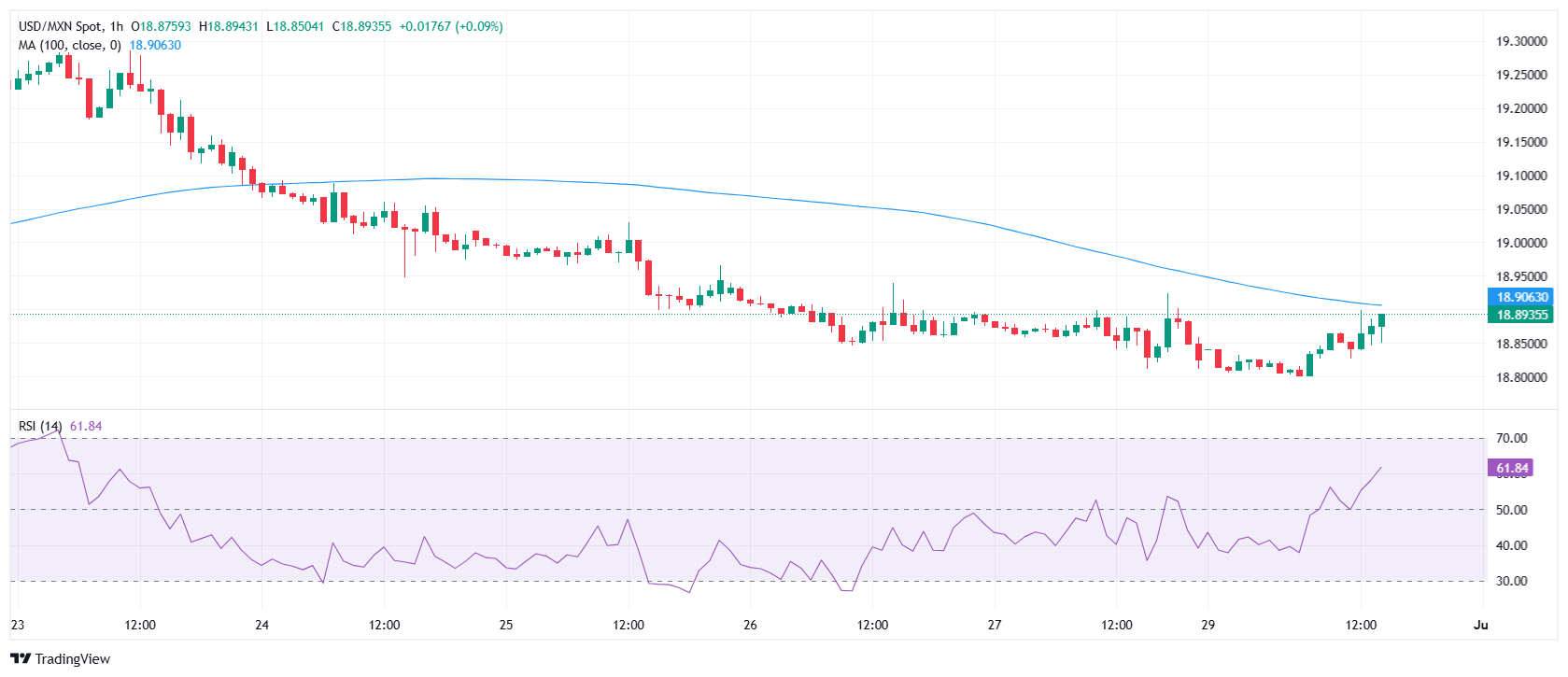- The USD/MXN bounces slightly up to new minimum of ten months in 18.80.
- Trump’s tax bill and fears on the independence of the Fed continue to weigh on the dollar.
- The technical perspective maintains the bearish trend despite a possible extension of the actutal rebound.
The USD/MXN opened the week falling to new minimums of ten months in 18.80, but before the opening of Wall Street rebounded to a daily maximum of 18.89. At the time of writing, the PAR is quoted over 18.86, winning 0.22% in the day, although it maintains its wide bassist trend.
The dollar falls to new minimums of more than three years due to the nervousness that provokes the Trump fiscal bill
The US dollar index (DXY) has fallen to a minimum not seen since February 2022 in 96.98 in the first part of Monday. The green ticket is weakened in a week that will be marked by the vote of the bill ‘Big Beautiful Bill’ proposed by Donald Trump. The US president is pressing to be approved before July 4, but the fears of the market due to the increase that would cause in the American deficit is affecting the dollar.
The uncertainty about the approval of the ‘Big Beautiful Bill’ is also weighing on the Mexican peso in the last hours despite the current weakening of the dollar. The plan would partially affect Mexico, since a game of 350,000 million dollars is expected to reinforce US borders and national security, of which 46,000 million would be allocated at the end of the border wall between the two countries. In addition, the clippings to Medicaid could leave many migrants from Mexico without coverage.
Together with fears for the aforementioned bill, markets remain cautious about Trump’s attacks on the independence of the United States Federal Reserve. The Republican could already announce in September or October the name of the successor of the president of the Fed, Jerome Powell. Scott Besent, current Secretary of the US Treasury Party as a favorite, which could question the reliability of the institution. This Tuesday, Powell will speak in the Central Banks forum held in Sintra (Portugal). The markets will be very attentive to their comments, since it could talk about the pressures received by Donald Trump and the head of the US monetary policy in the next meetings of the Central Bank.
Later in the week, attention will also be in the US employment data. Non -agricultural payrolls are ahead of Thursday, waiting for a generation of 110,000 jobs in June, below May 139,000.
USD/MXN Price levels
The relative force index (RSI) is maintained below 50 in medium and long term graphics, although it is above 50 in shorter periods of time, indicating a greater extension of the rebound.
The main support is now at a minimum of ten months recorded today at 18.80. A rupture of this level could find support in the 18.60 area, where are the soils of mid and late August 2024 and in the psychological area of 18.00.
Upwards, the first resistances are around 18.90/18.99, where the mobile socks of 100 periods in one and four hours are located. Above 19.00, the main barrier will be in 19.35, maximum of the last four weeks.
USD/MXN 1 hour graphic

Mexican weight FAQS
The Mexican weight (MXN) is the most commercialized currency among its Latin American peers. Its value is widely determined by the performance of the Mexican economy, the country’s central bank policy, the amount of foreign investment in the country and even remittance levels sent by Mexicans living abroad, particularly in the United States. Geopolitical trends can also affect MXN: for example, the Nearshoring process (or the decision of some companies to relocate the manufacturing capacity and supply chains closer to their countries of origin) is also considered a catalyst for the Mexican currency, since the country is considered a key manufacturing center in the American continent. Another catalyst for MXN is oil prices, since Mexico is a key exporter of the raw material.
The main objective of the Central Bank of Mexico, also known as Banxico, is to maintain inflation at low and stable levels (in or close to its 3%target, the midpoint of a tolerance band between 2%and 4%). To do this, the bank establishes an adequate level of interest rates. When inflation is too high, Banxico will try to control it by raising interest rates, which makes the indebtedness of homes and companies more cooling, thus cooling the demand and the economy in general. The highest interest rates are generally positive for Mexican weight (MXN), since they lead to higher yields, which makes the country a more attractive place for investors. On the contrary, lower interest rates tend to weaken the MXN.
The publication of macroeconomic data is key to evaluating the state of the economy and can have an impact on the valuation of the Mexican weight (MXN). A strong Mexican economy, based on high economic growth, low unemployment and high confidence is good for MXN. Not only attracts more foreign investment, but it can encourage the Bank of Mexico (Banxico) to increase interest rates, particularly if this fortress is accompanied by high inflation. However, if the economic data is weak, the MXN is likely to depreciate.
As an emerging market currency, the Mexican weight (MXN) tends to rise for periods of risk, or when investors perceive that the general market risks are low and, therefore, are eager to participate in investments that carry a higher risk. On the contrary, the MXN tends to weaken at times of market turbulence or economic uncertainty, since investors tend to sell higher risk assets and flee to the most stable safe shelters.
Source: Fx Street
I am Joshua Winder, a senior-level journalist and editor at World Stock Market. I specialize in covering news related to the stock market and economic trends. With more than 8 years of experience in this field, I have become an expert in financial reporting.







